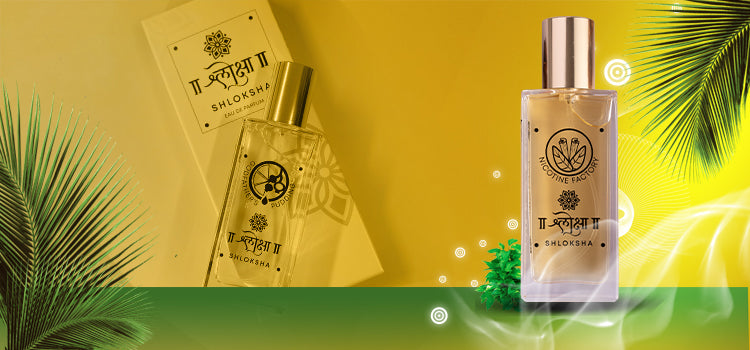
The Chemistry Behind Longevity: The Art and Science of Scent Endurance
Jay PatelShare
Within every bottle of perfume lies a meticulously crafted essence, a blend that is as much an art as it is a science. The key to its allure often lies in an invisible yet compelling force – the chemistry of longevity. This intricate dance of molecules and compounds shapes not just the initial encounter with the fragrance, but its enduring presence, weaving a story that lingers on the skin and in memory.
A molecular waltz: the building blocks of fragrance
Let’s embark on a microscopic journey into the heart of a perfume's essence. The molecular structure of perfume ingredients is akin to a delicate waltz performed by an array of diverse dancers – each with their role, rhythm, and style. Larger, heavier molecular dancers, such as musk and amber, glide gracefully across the skin, their movements slow and lingering. These are the molecules that give the fragrance its staying power, anchoring the lighter notes with their weighty presence.
Conversely, smaller, more agile molecules dash and twirl, creating the perfume's immediate and often intoxicating opening act. Citrus and floral notes, light and effervescent, introduce the fragrance with a burst of freshness, but like the opening dancers in a ballet, their presence is brilliant yet fleeting. This delicate balance between the light and the heavy, the quick and the slow, creates the symphony that is a perfume's signature.
Longevity's alchemists: compounds of endurance
Now, let us delve into the alchemy that defines a fragrance’s lasting power. Certain compounds are the unsung heroes of a perfume's endurance. Resins, woods, and certain synthetic elements are the steadfast pillars upon which the fleeting top notes rest. Their larger, more complex molecular structures create a slow dance of evaporation, which allows the fragrance to cling to the skin, unfolding its layers gradually, revealing its depth over hours rather than minutes.
These base notes are the custodians of time, ensuring that the initial melody of the top notes transitions smoothly into the rich, deep chords of the fragrance's heart and base. They are the storytellers, maintaining the narrative of the scent long after the initial notes have taken their bow.
The scent's symphony: volatile and non-volatile interplay
To truly appreciate a fragrance, one must understand the delicate interplay between its volatile and non-volatile components. The volatile elements are the fragrance’s spirited sprites, zesty and ephemeral. They awaken the senses with their immediate impact but soon dissipate into the air, their presence a memory as quick as a passing breeze.
The non-volatile components, in contrast, are the fragrance’s soul. They emerge slowly, a gradual unfolding of complex, often earthy notes that form the lasting impression of the scent. It’s in this gradual reveal that the true artistry of the fragrance comes to life – a narrative that evolves, telling a different story with each wearer, in each moment.
The role of base notes in longevity
The longevity of a fragrance largely hinges on its base notes. These are the scents that linger longest on the skin, long after the top and middle notes have dissipated. Base notes are the foundation upon which a perfume is built, providing depth and lasting power to the overall scent.
Characteristics of base notes
Rich and Deep: Base notes are typically richer and deeper than top and middle notes. They often have a balsamic, woody, or resinous quality that gives the fragrance its lasting impression.
Slow Evaporation: These notes evaporate much slower compared to the volatile top notes. This slow evaporation rate is what contributes to a perfume's endurance on the skin.
Molecular Stability: The molecules in base notes are more stable, making them less susceptible to quick degradation. This stability helps in prolonging the scent's presence.
Common base notes and their contributions
- Musk: Offers a warm, animalistic base that is both alluring and grounding.
- Vanilla: Known for its sweet, cozy, and comforting presence, it adds a touch of sensuality to the fragrance.
- Amber: Provides a rich, warm, and slightly sweet note that adds depth and longevity.
- Sandalwood: Offers a creamy, soft, and rich woody base that anchors the fragrance.
- Patchouli: Known for its earthy and dark qualities, it lends a robust base that complements lighter notes.
Impact on fragrance longevity
Anchoring the Scent: Base notes act as an anchor, holding onto the lighter notes and preventing them from evaporating too quickly.
Enhancing Complexity: These notes add complexity to a fragrance, evolving over time and revealing new facets of the scent.
Long-lasting Impressions: A fragrance's lasting impression is often attributed to its base notes, which remain detectable for hours after application.
Understanding the role of base notes in fragrance longevity highlights their importance in the art of perfumery. They are the final and most enduring notes in the olfactory journey, providing depth, warmth, and character to the fragrance. By choosing fragrances with rich and robust base notes, one can ensure a longer-lasting and more memorable scent experience.
Choosing long-lasting fragrances
Selecting a fragrance that endures through the day is as much an art as it is a science. The key to finding long-lasting scents lies in understanding their composition and the characteristics that contribute to their longevity. Here's how you can navigate this olfactory quest:
Understanding fragrance concentration
- Eau de Parfum (EdP): Contains a higher concentration of fragrance oils (typically 15-20%), which results in a longer-lasting scent.
- Eau de Toilette (EdT): Lighter than EdP with a 5-15% concentration of fragrance oils, suitable for a subtle, shorter-lived scent.
- Eau de Cologne (EdC): The lightest form with 2-4% concentration, offering a fresh but fleeting fragrance experience.
Identifying key base notes
Look for fragrances with pronounced base notes like musk, amber, patchouli, and sandalwood. These notes are known for their longevity.
Read the ingredient list or the fragrance pyramid if available, to gauge the balance of top, middle, and base notes.
Tips for selecting long-lasting fragrances
- Test on Skin: Fragrances react differently with skin chemistry. Always test on your skin and let it sit for a few hours to experience its true longevity.
- Seek Expert Advice: Don't hesitate to ask for recommendations from fragrance experts or sales associates in stores. They can guide you to scents known for their staying power.
- Research and Reviews: Look up online reviews and forums for personal experiences and recommendations on long-lasting fragrances.
Consider the occasion and season
- Warmer Scents for Cooler Months: Rich, warm perfumes often last longer and are more suitable for colder seasons.
- Lighter Scents for Warmer Months: In summer, lighter perfumes are preferable, but look for those with strong base notes to ensure longevity.
By understanding the factors that contribute to a fragrance's longevity, such as concentration levels and base note composition, and by considering personal and environmental factors, you can make informed choices. Remember, the perfect long-lasting fragrance should align with your personal style, occasion, and the season, creating a lasting impression and enhancing your overall presence.
Industry insights: techniques used by perfumers
Perfumers employ various techniques to boost fragrance longevity. Innovations in molecular chemistry and the use of fixatives are just some ways the industry enhances the staying power of scents. There's a continuous exploration of new ingredients and methods to create long-lasting, memorable fragrances.
Conclusion
Understanding the science behind fragrance longevity allows for a more informed and enjoyable scent experience. We encourage readers to apply this knowledge, experiment with different fragrances and application techniques, and share their experiences in the world of enduring scents.
